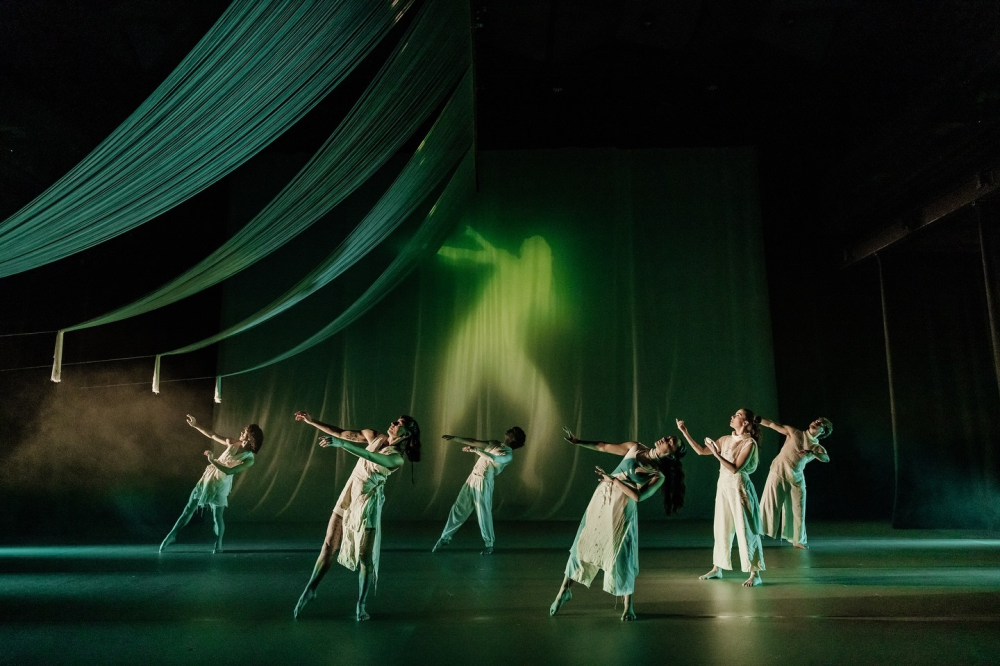Q Theatre
Auckland
25 July 2024
Reviewed by Perena Quinlivan (Ngāi Te Rangi, Ngāti Ranginui)

Andi Crown Photography
Whakataukī are an important feature of Māori culture, using symbolism and metaphor to convey key messages. Atamira’s purposeful choice of the well-known whakataukī, Kia whakatōmuri te haere whakamua, invites the audience to celebrate and access the cultural significance of this knowledge – KA MUA KA MURI.
Eddie Elliott’s (Ngāti Maniapoto) Remain, examines those elements which endure and sustain. This provides the context for what follows with Biance Hyslop’s (Te Arawa) work, Whakamaheahea, which allows a space for resilient rangatahi to shine, in a more contemporary cultural context.
Just as whakataukī celebrates the beauty of te reo, the symbolisim inherent in this accomplished production is unlocked early on with the programme’s inside first page which curiously is printed upside down. Is the audience being invited to look for what might be hidden? Or perhaps abandoned? By contrast, the programme’s blood red colour, suggests the tone of Papatūānuku, the sustainer of all living things, and mirrors the tone of Whakamaheahea, the second more trascendent piece of KA MUA KA MURI.


Andi Crown Photography
Remain opens the programme energetically with pulsating vibrancy. Tender and connected narratives are weaved together with realism and moments of comedy. The driving pulse of the music was matched by a sense of discomfort, culminating in the emotionally charged depiction of a maunga alongside the brutul face of colonialism. In the theatre space, which now increasingly embraces traditional artistic expressions and cultural practices from what were once potentially alien places, the maunga scene was particularly gripping.
The music’s dynamic pulse was matched by Toalei Roycroft’s willingness to commit to comedy as much as to tragedy, making clear the depth of mamae left behind. Her pacing, characterisation and movement were stand-outs. She enabled laughter but also silence in the most climatic moments where it was easy to surmise a deep empathy within the audience. Abbie Rogers also presented as technically strong with a controlled stage presence, ably interpreting the music through movement.
Whakamaheahea opened with the representation of a clock ticking, anchoring the piece with who and what would be seen. The experience of time moving within and between ourselves was captured powerfully with the repetitive use of the word “Grandparent” as a backdrop and a narrative. The audience was drawn into considering the many from our past who converge with us in the present. It is these tūpuna who embody us now.


Andi Crown Photography
The audience was taken on an absorbing journey of moods and mysteries in Whakamaheahea. The driver was a subtle but increasingly visceral power, and a throwing off of shackles. The accomplished use of kapa haka by Tai Taranui Hemana was pulsating but lost its way with dancers not as accomplished in traditional Māori dance. The work culminated in a flowing movement by all dancers delivering their own soliloquy, looking to the future with hope.
Rona Ngahuia Osburne’s set and costume design added to the production’s emotional impact. Long strips of thin material hung like deconstructed sails from a distant past in Remain. In Whakamaheahea the same material floated and shimmered sensuously like DNA strands, acting as a barricade and a hurdle for the dancers to smash through.
This work inspires a new generation of Atamira rangatahi. Congratulations to the wider Atamira whanau for providing such opportunities.
He mihi ki a koutou!
Glossary
Whatakaukī : a proverb, a significant saying, an aphorism which contains a general truth
Kia whakatōmuri te haere whakamua: I walk backward into the future with my eyes fixed on my past
Ka mua ka muri: walk backwards into the future (a loose, abbreviated translation of the above whakatauki)
Whakamaheahea: to free from obstruction, to clear
Papatūānuku: Earth mother and wife of Rangi-nui – from whom all living things originate
Mamae: pain, sore, hurt, ache, wounded
Tūpuna: ancestors, grandparents
He mihi ki a koutou! An acknowledgement/greeting to you all (plural)
Andi Crown Photography
Gallery is loading. Please wait. Javascript will need to be enabled to view it.

